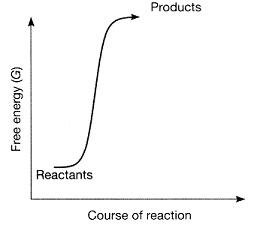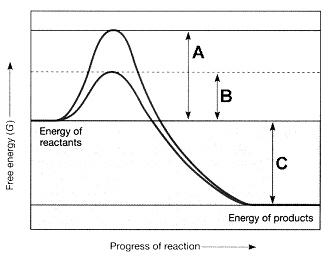Most components of energy conversion systems evolved very early; thus, the most fundamental aspects of energy metabolism tend to be:
very similar in a wide range of different organisms.
The ultimate source of energy for almost all living organisms is:
the sun.
Kilojoules are:
units of work.
The life and death of cells are governed by:
the laws of thermodynamics.
An organism can exchange matter and energy with its surroundings. Thus, any change in an organism's energy content must be balanced by a corresponding change in the energy content of the surroundings. As such, an organism is referred to as:
an open system.
Which of the following statements is contrary to the first law of thermodynamics?
When gasoline is burned, its energy is destroyed.
Which word is defined by this statement: A measure of this disorder, or randomness?
entropy
In order for a cell to maintain a high degree of order, it must:
constantly use energy.
The sum of all chemical activities taking place in an organism is:
metabolism.
Which of the following accurately represents the relationship between the terms anabolism, catabolism, and metabolism?
metabolism = catabolism + anabolism
Catabolic reactions involve the:
breakdown of large organic molecules to simple building blocks.
Pathways that have an overall energy requirement are referred to as:
anabolic reactions.
Every type of chemical bond contains a certain amount of energy. The total bond energy, which is essentially equivalent to the total potential energy of the system, is a quantity known as:
enthalpy.
An exergonic reaction is considered to be:
spontaneous.
Which of the following statements is true of spontaneous reactions?
The amount of free energy after the reaction is less than before the reaction.
When the free energy of the reactants is greater than the free energy of the products, such a reaction is referred to as:
an exergonic reaction.
In a reaction in which the rate of the reverse reaction is equal to the rate of the forward reaction, a state of __________ is attained.
dynamic equilibrium

Figure 7-1 Use the figure to answer the corresponding question(s). Which of the following statements about Figure 7-1 is true?
The reaction is endergonic, and also the products have more free energy than the reactants.

Figure 7-1 Use the figure to answer the corresponding question(s).Which of the following conclusions can be accurately derived from the Figure 7-1?
ΔG is positive.
Energy stored within the molecules of ATP is in the form of __________ energy.
potential
Consider the following two chemical equations:
- glucose + fructose → sucrose + H2O, ΔG = +27kJ/mole (or +6.5 kcal/mole)
- glucose + fructose + ATP → sucrose + ADP + Pi, ΔG = -5kJ/mole (or -1.2 kcal/mole)
The free energy change difference between the chemical equations (A) and (B) above is accomplished by:
combining an endergonic and an exergonic reaction.
Which of the following statements concerning ATP is FALSE?
It stores energy for long periods.
The reaction ATP + H2O → ADP + Pi is classified as an:
exergonic reaction.
Select the compound that contains the most energy:
ATP
Select the phosphorylation reaction:
glucose + ATP → glucose-P + ADP
The maintenance of a high ATP to ADP ratio within cells ensures that:
the hydrolysis of ATP to ADP will be strongly exergonic.
The transfer of electrons from one compound to another is equivalent to __________ transfer.
energy
__________ is a process where energy (as electrons) is released, whereas __________ is a process where energy (as electrons) is accepted.
Oxidation; reduction
XH2 + NAD+ → X + NADH + H+. In the preceding equation, NAD+ is said to be in a ____________ state and NADH is in a __________ state.
oxidized; reduced
Select the reduced molecule:
NADH
Select the hydrogen acceptor molecule that stores electrons in the process of photosynthesis:
nicotinamide adenine dinucleotide phosphate (NADP+)
FAD and cytochromes are classified as:
hydrogen or electron acceptors.
Because enzymes affect the speed of chemical reactions without being consumed, they are referred to as:
catalysts
Which of the following statements concerning enzymes is FALSE?
Most enzymes are RNA molecules.
Enzymes are important biological catalysts because they:
lower the activation energy of a biochemical reaction.
Which of the following statements concerning activation energy is FALSE?
Catalysts raise a reaction's activation energy.

Figure 7-2 Use the figure to answer the corresponding question(s). Refer to Figure 7-2. The line on the graph labeled B represents the:
activation energy with an enzyme.

Figure 7-2 Use the figure to answer the corresponding question(s). Refer to Figure 7-2. The line on the graph labeled C represents the:
change in free energy.
Parts of the enzyme molecule that interact with a substrate are called:
active sites.
The substance on which an enzyme acts is called the:
substrate
What refers to the situation in which the binding of a substrate to the enzyme causes a change in the enzyme's shape, facilitating an enzyme's function?
induced fit
Hydrolases are one important class of enzyme that function to catalyze:
splitting a molecule using water.
Which refers to an organic, nonpolypeptide compound that binds to the apoenzyme and serves as a cofactor?
coenzyme
Which of the following does not represent a method by which cells regulate enzyme activity?
heat denaturation of the enzyme
Select the enzyme that does not match the reaction:
kinase-breaks peptide bonds
If one continues to increase the temperature in an enzyme-catalyzed reaction, the rate of the reaction:
increases and then decreases rapidly.
You conduct an experiment in which you add increasing amounts of substrate to an enzyme solution and then measure the resulting reaction rate. You graph your results, plotting the rate of the reaction on the Y-axis versus substrate concentration on the X-axis. What do you conclude from your graph?
The reaction rate increases with increasing substrate concentration up to a point, above which the rate remains constant.
An allosteric enzyme:
allows a substance other than the substrate to bind to the enzyme, thereby activating or inactivating it.
Competitive inhibitors inhibit enzymatic reactions by:
temporarily bonding into the active site.
Penicillin is a drug that acts by:
irreversibly inhibiting transpeptidase.